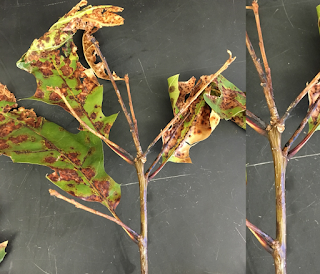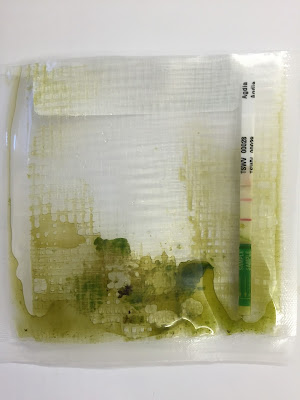Tubakia Leaf Spot
 |
| Tubakia leaf lesion on Oak. |
Tubakia sp. a fungal pathogen that causes a late season leaf spot and twig canker. All species of oak appear to be
susceptible to the disease but those in the red oak group ( black, red
& pin oak) appear to be most susceptible.
Tubakia leaf spot tends to develop in the late summer to early fall and begins as small reddish-brown foliar spots. As the disease progresses the leaf spots enlarge and may coalesce to form large blighted areas. Spotting may occurs on or near leaf veins causing death of the vein and collapse of leaf tissue beyond that point. Premature leaf drop and small twig cankers can form in severe cases.
Tubakia sp. overwinter in twig cankers and in infected leaf tissue on or around the tree. Spores are easily spread by wind and rain splash to uninfected tissue in the spring and early summer months. In most cases, Tubakia leaf spot is a cosmetic disease. In general, when leaf spots are sporadic, the ultimate damage to the plant is relatively insignificant. When leaf spots occur year after year on the same tree, cumulative damage may result in dieback and decline.
Management of Tubakia begins with good sanitation practices such as raking and destroying fallen leaves. This reduces the initial inoculum for the following year. Selectively pruning branches to increase air circulation within the tree canopy will further reduce the incidence and severity of the disease. Branches exhibiting cankers or dieback should also be removed from the tree. This will improve the appearance of the tree as well as reduce overwintering sites for the pathogen. Lastly ensuring that the tree is properly cared for (irrigation and fertility programs) will reduce plant stress and decrease susceptibility to the disease.
 |
Tubakia sp. causing leaf vein death and
collapse of leaf tissue beyond that point. |
 |
Advanced stages of Tubakia leaf spot note coalescing
lesions, twig cankers and premature defoliation. |
 |
The conidia (dark, ovoid structures pictured here) are produced
by the fungus and serve as inoculum for new infections. |
|








